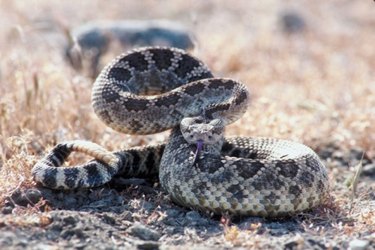Things You'll Need
Cleaver or sharp, heavy knife
Very sharp knife
Soft towel
Borax powder
Water
Two 5-gallon plastic buckets
1 lb. ammonia alum
4 oz. crystallized sodium carbonate
Paint stirrer
Plywood scrap slightly larger than the snake skin
Upholstery tacks
Tack hammer

The complete process for tanning a snakeskin involves skinning, fleshing, salting, tanning and stretching. Borax is usually used to "salt" the skins before they are soaked in the tanning solution, the most ancient of which is tannic acid, which gave process its name. Alternatively, some taxidermists simplify the process by pickling skins in a solution that includes borax after salting.
Step 1
Cut the head off the rattlesnake with a cleaver or sharp, heavy knife. Use caution when decapitating the snake. Rattlesnakes may bite on reflex for up to 30 minutes after they die.
Video of the Day
Step 2
Turn the rattlesnake belly-side up. Slice open the rattlesnake from the anus to the neck with a very sharp knife. Work your fingers under the skin and pull it off.
Step 3
Lay the snakeskin flesh-side up on a soft towel on a flat surface. Remove all fat and flesh from the inside of the snakeskin by scraping in the direction of the scales with a very sharp knife.
Step 4
Rub the inside of the skin with a generous amount of borax powder. This process is called salting. The skin should be coated with borax when you are done. Let the skin sit undisturbed for 24 hours.
Step 5
Rinse the borax from the skin with water, pat the skin dry with a towel and repeat salting the skin with borax. This process is intended to draw all moisture from the skin.
Step 6
Dissolve 1 lb. of ammonia alum in 1 gallon of water in a 5-gallon plastic bucket. Dissolve 8 oz. of borax and 4 oz. of crystallized sodium carbonate in 1/2- gallon of water in a second 5-gallon bucket.
Step 7
Pour the borax and sodium-carbonate solution into the alum solution and stir with a paint stirrer. Immerse the snake skin in this solution for five days.
Step 8
Remove the snake skin from the tanning solution. Pat the skin dry with a towel. Tack the skin, scale-side out, to a plywood scrap slightly larger than the snakeskin, using upholstery tacks and a tack hammer.
Tip
Freeze live rattlesnakes after capture and bagging to avoid damaging their skins.
Warning
Rattlesnakes have seven or more sets of fangs that remain poisonous long after the snake is dead.
Video of the Day